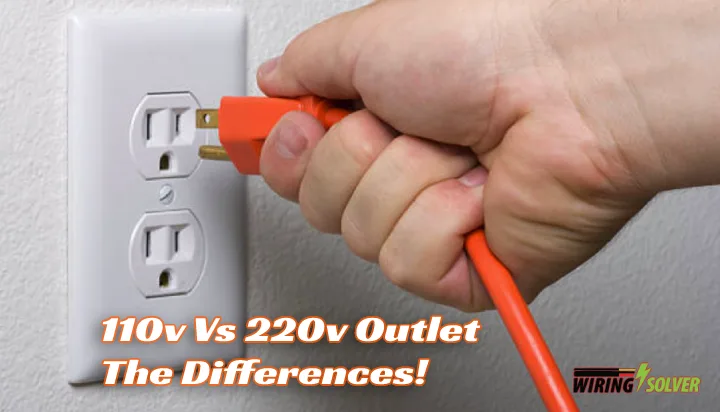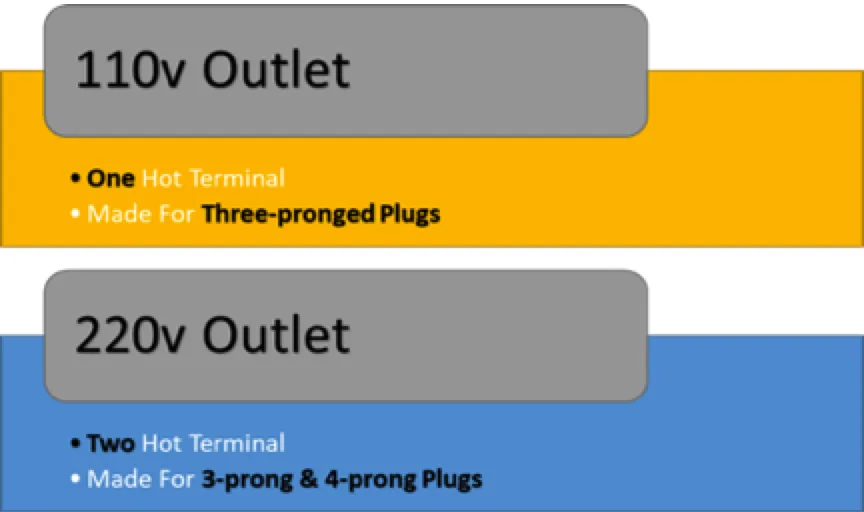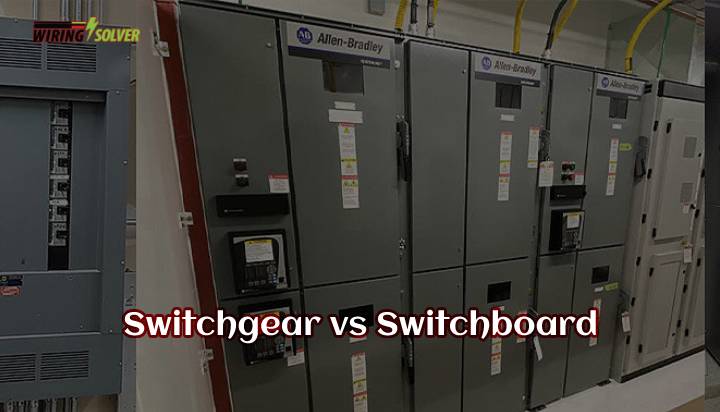Outlets are the primary doorway between an electrical device or appliance and its source of power. Therefore, the decision to choose the perfect outlet must be taken appropriately. But, what about 110v Vs 220v outlet?
There are several key differences between a 110-volt outlet and a 220-volt outlet. The most obvious one is the voltage. Apart from that, the frequency, wire gauge, no. of prongs, outlet size, etc. are other such important factors.
Read through the article properly in order to learn more about these outlets and their differences.

What is the Difference Between a 110V and 220V Outlet?
There are major differences between a 110v and a 220v outlet. Ranging from power and preferred use case. These differences are showcased in the table provided below:
110V Vs 220V Outlet
Difference | 110 Volt | 220 Volt |
Voltage | 110 Volts | 220 Volts |
Frequency | 50 Hz | 60 Hz |
Effectiveness in Generation | Less Effective | More Effective |
Wire Gauge | Requires a Thicker Wire | Requires a Thinner Wire |
Prongs | 3 Pronged Plugs | 3 Pronged Plugs or 4 Pronged Plugs |
Outlet Size | Visually Smaller | Visually Bigger |
Risk of Electrocution | Lower Risk of Electrocution | Higher Risk of Electrocution |
Advantages | Safe, Inexpensive, Popular | Thinner Wires, Efficient, Saves Power |
Drawbacks | Thicker Wires, Less Efficient | Costly, Risky |
Which Outlet is Better? 110V or 220V?

The answer to this question depends on you and your specific use case. The necessity of the voltage depends on the task. A further brief on the topic is provided below.
Factors to Consider when Choosing the Appropriate Voltage
Voltage
This is the most obvious one. The voltage is the first difference between these two outlets. It also dictates how many watts the outlet can handle.
If your device requires a 110-volt power supply, you should use a 110v outlet. Otherwise, if it requires a 220-volt power supply, go for a 220-volt outlet.
Frequency
Frequency is also another important factor to consider when choosing an outlet.
A 110-volt outlet runs on a 50 Hz power supply whereas a 220-volt outlet runs on 60 Hz. 60Hz systems tend to use more voltage for the domestic power supply than 50Hz.
Effectiveness in Generation
A 110-volt outlet or 50Hz power is comparatively less effective in the generation of electricity.
But 60 Hz or 220-volt is more efficient in both the generation and transmission of power or electricity in general.
Wire Gauge
Lower voltages as such as 110-volt usually require a thicker gauge. But on the other hand, a 220-volt power supply outlet requires a thinner wire.
Prongs
The discussion of prongs is also necessary. If the number of prongs doesn’t match between your device and the outlet, then it may become difficult for you to use that outlet, even if it matches the device in other areas.
In a 110-volt outlet, the sockets are 3-pronged. But in a 220-volt outlet, the socket might be 3-pronged or 4-pronged. 4-pronged outlets require 4 wires. Installing a GFCI outlet with 4 wires is quite easy.
Outlet Size
A 10-volt outlet is visually smaller when compared to a 220-volt outlet. This could affect your decision if you have a shortage of space.
Risk of Electrocution
The lower the voltage, the lower the risk of electrocution. By that law, you can easily dictate that a 110-volt outlet possesses a lower risk of electrocution.
And based on the same rule, we can determine that a 220-volt outlet has a greater risk of electrocution.
What’s Inside a 110-Volt or 220-Volt Outlet?
If you look at a 220V to 110V wiring diagram, you’ll note that a 220V circuit has two hot wires. That means a 220V plug has to have an extra hot terminal, which is brass by convention
Also by convention, the hot wires are colored black and red. A 110V outlet (and plug) has only one hot terminal, and the hot wire is always black.
Another key difference between 110 and 220 circuits is the wire size. Because 220-volt circuits carry higher current, they require 10 gauge or larger wire.
Whereas the normal maximum wire size in a 110-volt circuit is 12 gauge. The terminal screws in 220V plugs and outlets are accordingly larger.
Each 110-volt circuit connects to a single bus bar and has only one hot wire, so only one circuit breaker is needed. By contrast, a 220-volt circuit connects to both bus bars, so two breakers are needed – one for each bus bar and each wire that connects to that bar.
A 220-volt breaker is known as a double-pole breaker, and it consists of two 110-volt breakers bonded together. It is possible to wire a 220-volt outlet with 3 wires as well.
Frequently Asked Questions (FAQs):
1. Can I run 220v through a 110v outlet?
It’s a bad idea according to most experts. If you connect a 220v over 110v outlet, it might cause the connected gadget to act weirdly or get damaged as most electronic devices can’t endure 50% under voltage.
2. Is it ok to plug 110V to 220V?
No. it may cause overvoltage which might result in electronic fires or blasts due to heavy access to power than its standard.
3. Are most outlets 110 or 220?
Mostly used electrical outlets in houses are 110 volts. However, some people use 120-volt outlets. And both of them are not the same
Summary
In case you wanted to know more about the differences that set apart a 110-volt outlet from a 220-volt outlet, this article should have helped you. The key differences have been discussed throughout the whole article.
A guide has also been provided to help you decide the proper outlet for yourself. However, if you have any doubts, do not hesitate to refer to a professional electrician.





